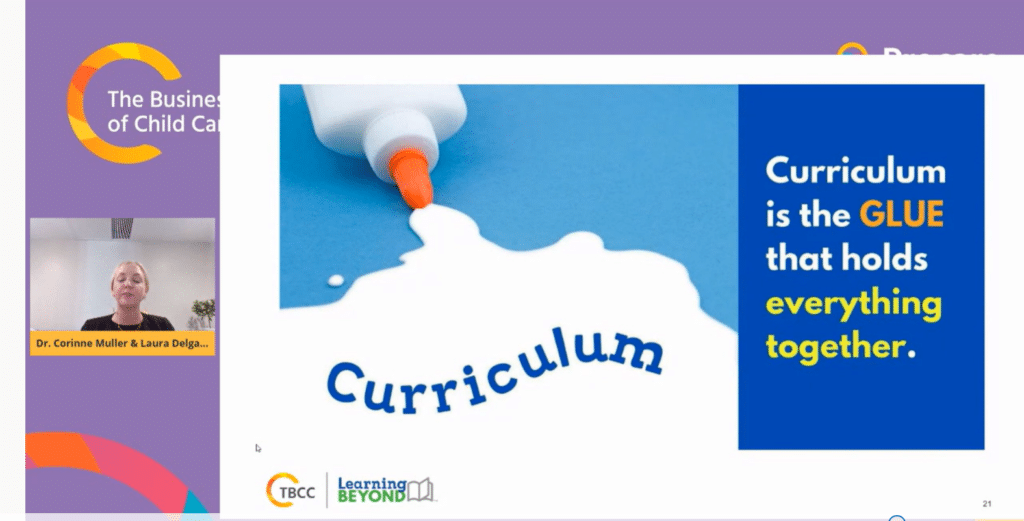
Curriculum has a direct impact on enrollment and staffing. And if teachers are struggling to effectively implement the curriculum you’ve chosen for your child care center, it may be time to take a close look at ways you can train and support your staff.
“Curriculum touches every aspect of your business,” said Dr. Corinne Muller, chief operating officer at Learning Beyond Paper, a company that specializes in creating online, early learning curriculum.
And its effect on hiring and staff retention cannot be overstated.
Identifying pain points early can support retention and ensure efficacy in your approach with children. At Procare’s virtual The Business of Child Care Conference held July 21, Corinne demonstrated the importance of maximizing your curriculum’s potential and improving teacher-child interactions.
She and Laura Delgado, vice president of curriculum and professional development at Learning Beyond Paper, gave session attendees several tools, tips and strategies to promote effective curriculum use, create stronger connections with staff and families and provide high-quality early learning experiences for children.
Giving Teachers The Tools They Want

The online curriculum developed by Learning Beyond Paper was intentionally designed and not a COVID Band-Aid, Corinne said.
Today’s teachers want easy access to lesson plans and don’t want to look up something they need in a binder stuffed with papers.
When they developed their program’s curriculum, it was done knowing what teachers need and want because the leaders at Learning Beyond Paper came from education, said Laura.
“The best way to support your teachers is by having a curriculum that supports them,” she said.
She gave the following tips on how to help teachers:
- Provide open-ended questions and prompts
- Provide free access to training and opportunities for in-service hours
- Allocate time for lesson planning and prep
- Create time for teacher reflection
- Encourage sharing of ideas
- Have a process/platform that makes ordering materials simple
And while it has always been vital to support teachers, it’s especially vital as child care centers grapple with teacher shortages.
Cindy Lehnhoff, director of the National Child Care Assocation, recently told CNBC that the child care industry lost 350,000 employees, roughly a third of its workforce, during the pandemic.
“When you have high staff turnover, that affects children,” Laura said. That includes their behavior.
“Your program is only as strong as your weakest teacher,” she said.
Assessing Your Curriculum Needs and Goals
Make sure your curriculum goes beyond academics and addresses the social and emotional needs of children, Laura said.
Laura cited the National Association for the Education of Young Children’s standard about what to look for in a curriculum:
- Ask about the program’s curriculum and how it addresses all aspects of child development. The curriculum should not focus on just one area of development.
- Children are given opportunities to learn and develop through exploration and play, and teachers have opportunities to work with individual children and small groups on specific skills.
- Materials and equipment spark children’s interest and encourage them to experiment and learn.
- Activities are designed to help children get better at reasoning, solving problems, getting along with others, using language and developing other skills.
- Infants and toddlers play with toys and art materials that “do something” based on children’s actions, such as jack-in-the-box, cups that fit inside one another and Play-Doh.
“When you’re setting up your programs and running your programs, really the best way for children to learn is in small groups,” she said.
Laura and Corinne asked session participants to share successes and challenges with their curriculums. Successes included that children typically were well-prepared for Kindergarten, that children were engaged and excited about activities and that they accomplished goals. Challenges cited including not having enough time to prep, children with behavior challenges, teaching children of many ages at once and worry that new teachers aren’t being properly trained because of staffing shortages.
As you think about your curriculum, she encouraged asking yourself the following questions:
- Are you satisfied with the curriculum you currently use?
- Do your teachers have easy access to the curriculum tools used throughout the day?
- Are your teachers using the curriculum to its fullest?
- Do your families know what curriculum your program uses?
- Does your curriculum offer daily communications for families?
- Does your curriculum support the needs of today’s teacher new hires?
“Everything we do is for children,” Laura said.
Corinne encouraged leaders at child care centers to “put on your curriculum lenses” and take a walk through your center. Take notes on what you see and hear, then reflect on those observations and think of ways you can adjust your curriculum to best suit the needs of the staff and the children in your care.
Keep Your Families Involved in Your Curriculum

It’s our job to sit parents down and explain the curriculum to them so everyone is on the same page, Laura said. For instance, parents need to understand that their 3-year-old won’t learn to read and write.
She suggested that child care centers review and optimize their communication approach, host a curriculum night (which can be done virtually) for parents, walk families through your curriculum approach, explain the “why” behind lessons and activities, display children’s work, share ways to extend the learning at home and encourage families to be ambassadors for your program to support enrollment.
“You want to make sure you have a solid curriculum foundation and plan in place at your school,” Corinne said. And you should be talking about it when you give tours of your center.
Learn More!

Procare would like to thank Corinne and Laura for sharing their expertise with attendees at The Business of Child Care Conference!
Did you miss their session? No worries! If you registered for the conference, you can log into the conference platform to catch up on software circles and breakout sessions.
And we’ll keep offering you ways to keep learning and optimize your business! Don’t forget to subscribe to Procare’s The Child Care Business Podcast and please join us for the following upcoming free webinars held each month as part of the Thrive in 2021 series:
- The Overwhelm Loop: Running Your Business So It Doesn’t Run YOU: On Sept. 15 at 1 p.m. ET, Kris Murray, president and founder of The Child Care Success Company, will tell you how to approach your business with a “systems mindset” and how to be a more productive leader in any ECE environment.
- 9 Reasons Why Child Care Businesses Are Thriving with Systems for Operations and Management: On Oct. 20 at 1 p.m. ET, Andrea Dickerson, owner of IOwnADaycare.com, will share the foundational must-haves happy child care owners use for optimizing their organizational structure.
Click here to register to attend the webinars!
And remember, Procare is always here to help or answer questions. If you’re a center not yet using Procare to manage your business and help with billing, request a free demo today!



